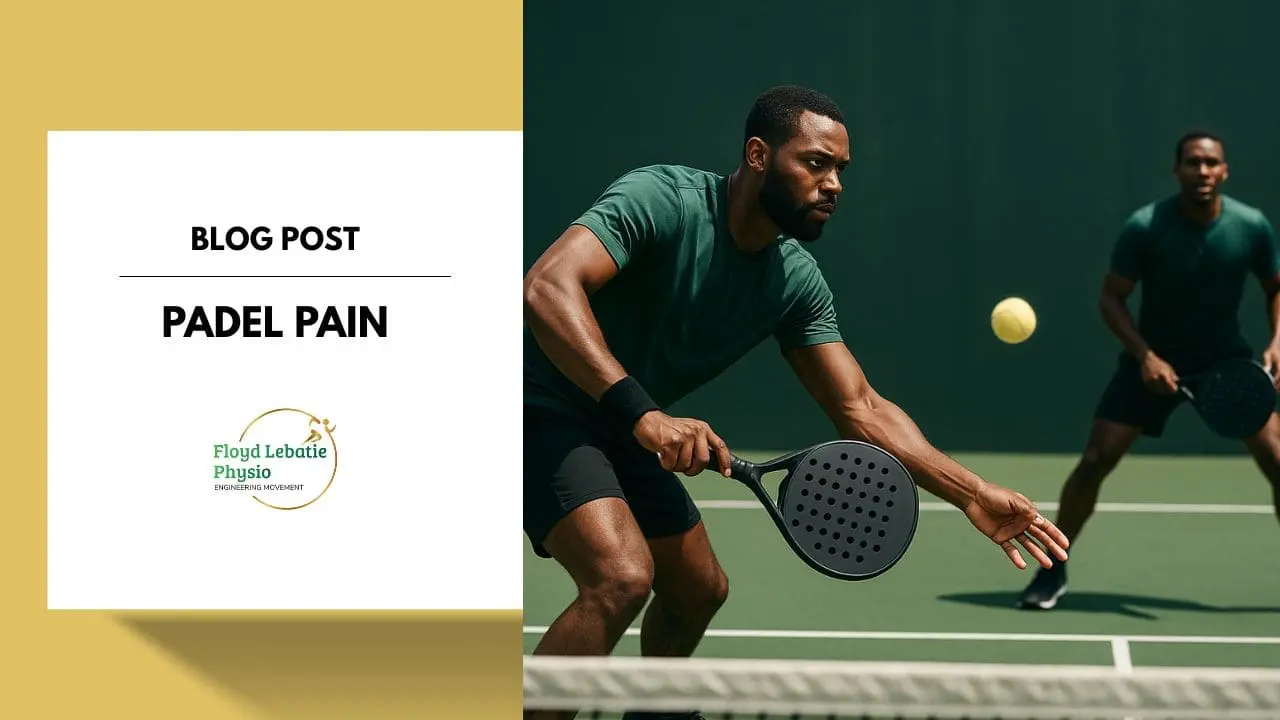Painful Padel: Your Questions Answered
Padel is growing rapidly around the world—and so are injury risks. From explosive lunges and lateral movements to overhead shots and intense rallies, the sport places unique demands on the body. Below, we break down what every player, parent, and coach should know to stay safe and perform at their best.
Which joints and muscles are most involved in padel?
Key areas that serve both power and control include the:
- Upper limb: shoulder, elbow, wrist.
- Lower limb: ankle, knee, hip.
- Core and back: essential for stabilization, rotation, and overhead strokes.
What are the typical movement patterns in padel?
Padel involves:
- Lateral movements, sudden changes of direction, and short sprints.
- Frequent overhead strokes (volleys, smashes).
- Explosive lunges toward the net to reach balls.
- Rapid rotational and deceleration actions unique to the glass-walled court.
What are the common mechanisms of injury?
- Rotator cuff tendinopathy/shoulder strain from repetitive overhead strokes.
- Tennis elbow due to repetitive racket use.
- Ankle sprains from quick directional changes.
Which functional movement tests help assess padel players?
A practical assessment should cover:
- Mobility: shoulder internal/external rotation, ankle dorsiflexion, hip range.
- Stability: single-leg balance, core plank holds.
- Strength: shoulder rotators, grip, quadriceps, hamstrings, calf.
- Power & agility: lateral hop, explosive lunges, quick-direction change drills.
How can warm-up routines protect against injuries?
A padel-specific warm-up should include:
- Dynamic stretches for hips, calves, thoracic spine, shoulders.
- Agility and lateral movement drills (side shuffles, carioca).
- Racket-specific stroke rehearsals and shoulder activation (light band work).
- Progressive increase in intensity to prime the body.
What strength and conditioning exercises reduce risk?
- Shoulders: rotator cuff strengthening, scapular stabilisation.
- Core: anti-rotation (Pallof press), plank variations, trunk control.
- Lower limbs: lateral lunges, single-leg squats, hamstring bridging, calf raises.
- Agility: resisted side shuffles, reaction drills, shuttle runs.
What recovery strategies work best?
- Track training vs match load – avoid sudden spikes.
- Monitor early pain.
- Stretch post-play.
- Use ice and load management for flare-ups; seek physiotherapy if pain persists.
Key Takeaways:
- Injuries in padel are common, with rates up to 95% per season.
- Most affected areas are the elbow, ankle, shoulder, knee, and back.
- Movement demands include lateral shuffles, overhead strokes, and explosive lunges.
- Functional assessments, targeted warm-ups, and strength training reduce risk and boost performance.
At Floyd Lebatie Physiotherapy, our goal is simple: help you move better, play stronger, and stay on court longer.
References:
- Rojas-Valverde D, et al. Padel related injuries: prevalence and characteristics in Chilean amateur players – a cross-sectional analytic study. BMC Sports Sci Med Rehabil. 2025;17(1):12. doi:10.1177/17479541231191739
- López-Rodríguez A, et al. Epidemiology of padel injuries and risk factors. Rev Cub Med Dep. 2024;19(2). doi:10.34982/2223.1773.2024.V9.No2.004
- Dahmen J, Emanuel KS, Fontanellas-Fes A, Verhagen E, Kerkhoffs GMMJ, Pluim BM. Incidence, prevalence and nature of injuries in padel: a systematic review. BMJ Open Sport Exerc Med. 2023;9(2):e001607. doi:10.1136/bmjsem-2023-001607
- Pérez F, de la Rubia A, Cañadas E, Lorenzo-Calvo J, Marquina M, García-Sánchez C. Musculoskeletal injury prevalence in professional padel players: a retrospective study of the 2021 season. Phys Ther Sport. 2023;60:1–8. doi:10.1016/j.ptsp.2023.06.003
- Pérez F, de la Rubia A, Cañadas E, Lorenzo-Calvo J, Marquina M, García-Sánchez C. Musculoskeletal injury prevalence in professional padel players: a retrospective study of the 2021 season. Phys Ther Sport. 2023;60:1–8. doi:10.1016/j.ptsp.2023.06.003


